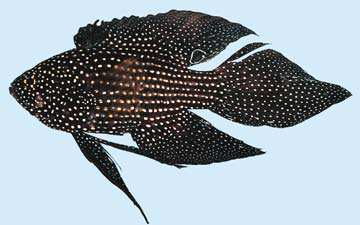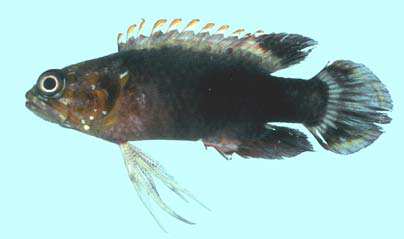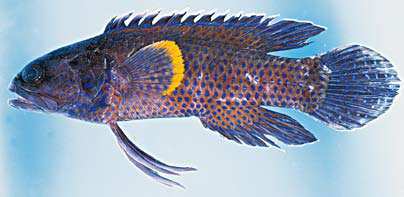PLESIOPIDAE
Roundheads (Longfins)
By Hiroyuki Motomura
 Calloplesiops altivelis |
 Plesiops coeruleolineatus |
 Plesiops corallicola |
|
Small to medium-sized fishes, less than 30 cm total length. Body elongate to oblong. Third branchiostegal ray projecting farther posteriorly than adjacent rays. No spines on opercle. A continuous dorsal fin with IX-XXVI spines and 2-11 soft rays; deeply incised-fin membranes between spines in some species. Anal fin with III-XVI spines and 2-11 soft rays. Caudal fin usually rounded, sometimes elongate to lanceolate or forked. Pectoral fins 14-30 rays. Pelvic fins usually long, with I spine and 2-4 soft rays; first soft ray bifurcate, often elongate or considerably thickened. Lateral line incomplete or disjunct, a more anterior dorsal lateral line running near dorsal-fin base, a posterior lateral line running midlaterally onto caudal peduncle, and occasionally a ventral lateral line as well; scales often cycloid anteriorly, ctenoid posteriorly. Color: highly variable, even changeable for individuals from solid to spotted or barred. Spinous portion of dorsal fin often with yellow or red tips. Similar families occurring in the area. Pseudochromidae: Dorsal fin with III or fewer spines and 21 or more soft rays. Anal fin with 13 or more soft rays. Serranidae: three spines on opercle. Opistognathidae: large eye and mouth; posterior margin of maxilla extending well beyond eye. Dorsal fin with weak spines. Pelvic fin with I spine and 5 soft rays. Remarks. Occurs on coral reefs and tide pools to depths of 30 m, sometimes deeper. Solitary, sometimes schooling in caves and overhangs. No commercial catch, but popular in aquarium trade in some species. |

|
|